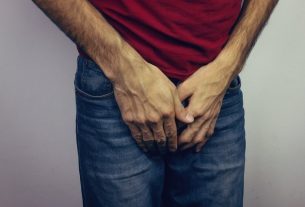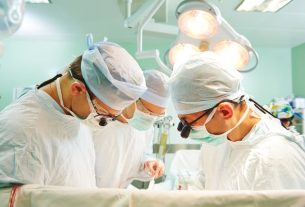Lumps on the penis, often similar to pimples, can appear at any age and, in most cases, are related to benign problems such as pearly papules or Fordyce granules, for example. Furthermore, there are also other changes that can cause the appearance of this type of lesion, such as lymphocele, lichen planus or genital warts.
However, as they are a change in the image of the penis, they can cause anxiety in men because they think they could be a sign of cancer. Although cancer is a very rare situation, it can also cause this type of symptom and, therefore, it is important to consult a urologist to identify the correct problem and begin the most appropriate treatment.
Main causes
The most common causes of a lump or pimple on the penis are:
1. Pearly papules
These papules, also known as Tyson, are small white balls, similar to pimples, that can appear under the head of the penis, and are often confused with genital warts. These are normal, benign glands that are present from birth, but generally only appear during adolescence. In addition to the aesthetic change, these glands do not cause pain or any other major change.
How to deal with: normally no treatment is necessary, however if the papules cause a major change in the image of the penis, the urologist may recommend cryotherapy or cauterization treatments in the office. See more about pearly papules (glands of Tyson) and how to treat it.
Allergy is one of the most common and least serious causes of pimples on the penis, which can appear due to the use of some types of soap, condoms, lubricant or even contact with some type of fabric, especially if it is synthetic fabric, rather than cotton, for example.
How to deal with: It is important to try to identify what is causing the allergy to avoid contact with the fabric or substance. Therefore, it is recommended to always try to wear cotton clothes and use soaps that are suitable for the intimate area or that do not contain many chemicals and perfumes. Furthermore, if you suspect an allergy to latex, you should avoid using condoms made from this material and opt for synthetic polyisoprene ones.
3. Ingrown hair
Ingrown hair occurs when a hair that has been eliminated grows back and curls inside the skin, leading to the appearance of small red balls, which can cause pain.
How to treat it: Ingrown skin usually improves without treatment. However, in cases where signs of inflammation and infection are seen, the doctor may recommend the application of antibacterial ointment.
4. Granules Fordyce
The granules of Fordyce They are a very common and benign change that causes the appearance of small white or yellowish balls on the head or body of the penis, and are not related to any type of sexually transmitted disease. Although they are more common during adolescence, due to hormonal changes, they can appear at any age.
How to deal with: the treatment is carried out solely for aesthetic reasons and may include several techniques such as the use of tretinoin gel, prescribed by the urologist, or the use of a laser to eliminate the granules. It is often not possible to completely eliminate this type of change. See more about how to treat Fordyce granules.
5. Genital warts
Genital warts are caused by an infection with the HPV virus that causes changes in the skin of the penis, which maintain the color of the affected area but are rough and rough to the touch, similar to the upper region of a cauliflower. These warts can vary greatly in size, but they are usually not painful and can be seen with the naked eye.
Normally, genital warts appear after unprotected intimate intercourse, whether anal, vaginal or oral, with an infected person. Understand better what warts on the penis mean and what to do.
How to deal with: when symptoms exist, ointments such as Podophylline, prescribed by the urologist, can be used to eliminate warts. However, it is common for warts to reappear, as it takes the body several years to eliminate the virus. Find out more details about HPV treatment in men.
6. Herpes
Genital herpes is a sexually transmitted infection (STI) caused by the herpes virus. herpes simplex, which can be transmitted through unprotected sexual intercourse. Infection with this virus can lead to the appearance of blisters or lumps on the penis, which can rupture and form wounds, which are itchy and painful. Herpes sores, in addition to appearing on the penis, can also appear in the perianal region or anus.
How to deal with: In the case of having had unprotected sexual intercourse or suspected of having had contact with a potentially infected person, it is recommended to consult a urologist so that a clinical evaluation can be carried out and, if the infection is confirmed, to initiate appropriate treatment, and it is important to notify the person with whom you had sexual relations so that they can also undergo treatment.
7. Molluscum contagiosum
Molluscum contagiosum is an infectious disease caused by the virus Poxvirus, which can affect the genital region and cause the appearance of small spots or blisters that do not cause pain and are skin-colored, and can be seen on any part of the body, with the exception of the hands and feet. The spots and/or blisters caused by molluscum contagiosum are small, ranging from 2 to 5 mm in diameter, but in people with a weaker immune system, they can be up to 15 mm in diameter.
This infection is transmitted through direct contact with the blisters during sexual intercourse or through sharing the clothes or bath towels of infected people.
How to deal with: Treatment should be guided by a dermatologist or pediatrician, in the case of children, and the use of topical medications such as 5% Imiquimod or Tretinoin may be recommended, in addition to cryotherapy or laser therapy being recommended in some cases.
8. Lymphocele
This is a type of hard lump that can appear on the shaft of the penis, especially after sexual contact or masturbation. It happens when the lymphatic system is not able to remove liquids from the penis due to the swelling of the erection, which closes the lymphatic pathways. Lymphocele usually disappears within a few minutes or hours after it appears.
How to deal with: it is a benign change that disappears on its own and, therefore, does not require any type of medical treatment. However, massaging the lump can help the liquid drain more quickly. If the lump does not disappear after several hours, you should consult a urologist to identify the cause and begin treatment.
9. Lichen planus
Lichen planus is an inflammation of the skin that can affect the penis and causes the appearance of small bumps, pimples or red lumps that are very itchy. There is no known cause for this problem, but it usually disappears on its own after a few weeks, and may recur several times over time.
How to deal with: treatment only helps to reduce symptoms and, in most cases, is done with the use of corticosteroids in the form of ointments or creams. However, your doctor may also prescribe an antihistamine, especially if there is severe itching. Learn more about lichen planus.
10. Disease Peyronie’s
The disease of Peyronie’s It does not have a specific cause, but it is responsible for causing the development of hard plaques in the corpus cavernosum of the penis, which can manifest as hard lumps on one side of the penis. Furthermore, it is also common for other symptoms to appear, such as a painful erection or bending of the penis during an erection.
How to deal with: the urologist can use Collagenase or Verapamil injections directly into the lump to reduce the fibrosis process that is causing its growth, but, in most cases, surgery is necessary to correct the changes. Discover all the treatment options for this disease.
11. Penile cancer
This is one of the rarest types of cancer, but it can also cause the appearance of lumps, ulcers or sores, especially on the head of the penis. This type of cancer is more common in men over 60 years of age, who are smokers and who do not have adequate hygiene in the region, but it can also occur when there is inadequate exposure of the region to ultraviolet radiation or when there is prolonged exposure to irritants.
How to deal with: Treatment almost always starts with surgery to remove as many cancer cells as possible, followed by chemotherapy or radiotherapy. In more serious cases, it may be necessary to remove the penis to prevent the cancer from spreading throughout the body. Check out other signs of penile cancer and how it is treated.
12. Lichen nitidus
Lichen nitidus is a rare and chronic inflammation of the skin that causes the appearance of flesh-colored or pink bumps in the genital region, folds, abdomen and chest. These lumps are usually asymptomatic, however they can itch at times.
How to deal with: In general, lichen nitidus disappears spontaneously within a few months to a year, without the need for specific treatment. However, the doctor may recommend treatment in cases where the lesions cause symptoms or when they cause aesthetic discomfort, and the use of topical and/or oral corticosteroids may be recommended.

Sign up for our newsletter and stay up to date with exclusive news
that can transform your routine!
Warning: Undefined array key "title" in /home/storelat/public_html/wp-content/plugins/link-whisper-premium/templates/frontend/related-posts.php on line 12
Warning: Undefined array key "title_tag" in /home/storelat/public_html/wp-content/plugins/link-whisper-premium/templates/frontend/related-posts.php on line 13




